|
ChSciTE Documentation
ChSciTE is an Integrated Development Environment (IDE) to edit and run C/Ch/C++ programs in Ch.
Ch
is an embeddable C/C++ interpreter for cross-platform scripting,
shell programming, 2D/3D plotting, numerical computing, and embedded
scripting.
The user interface of ChSciTE can be in one of over 30 local languages such as
German, French, Chinese, Korea, and Japanese.
Getting Started
ChSciTE can be launched by running the command
chscite.
In Windows, ChSciTE can also be conveniently launched by clicking its icon shown in
Figure 1 on a desktop.

Figure 1: A ChSciTE icon on a desktop in Windows
When the ChSciTE is launched, its graphical user interface will
appears as in
Figure 2.
The information as described here will be displayed if clicking
Help | ChSciTE Help command.

Figure 2: Get on-line help on how to use ChSciTE.
Editing and Executing C/Ch/C++ Programs
Text editing in ChSciTE works similarly to most Macintosh or Windows editors such as Notepad with the added
feature of automatic syntax styling.
ChSciTE can hold multiple files in memory at one time but
only one file will be visible. ChSciTE allows up to 20 files to be in memory
at once.
Rectangular
regions of text can be selected in ChSciTE by holding down the Alt key on Windows or the Ctrl
key on GTK+ while dragging the mouse over the text.
There are two panes in ChSciTE, the editing pane and the output pane. The output pane is
located either to the below of the editing pane or on the right. Initially it is of zero size, but
it can be made larger by dragging the divider between it and the editing pane.
The Options |
Vertical Split command can be used to move the output pane on the right of the editing pane.
With Ch installed on the machine,
the edited program can readily be executed in ChSciTE like in other IDE such as Microsoft Visual Studio. The source files are executed interpretively
without compilation. The output from the program
are directed into the output pane.
The First Example of Editing and Executing a Program with Output.
For example, open
a new document, type:
#include <stdio.h>
int main() {
printf("Hello, world!\n");
return 0;
}
as that document's text.
The same program hello.c in CHHOME/demos/bin/hello.c, where CHHOME is the home directory for Ch such as C:/Ch in Windows for
C:/Ch/demos/bin/hello.c,
can also be loaded using File | Open command.
The program should now appear coloured with syntax highlighting as shown in
Figure 3.

Figure 3: Program hello.c
Save the document as hello.c as shown in
Figure 4.
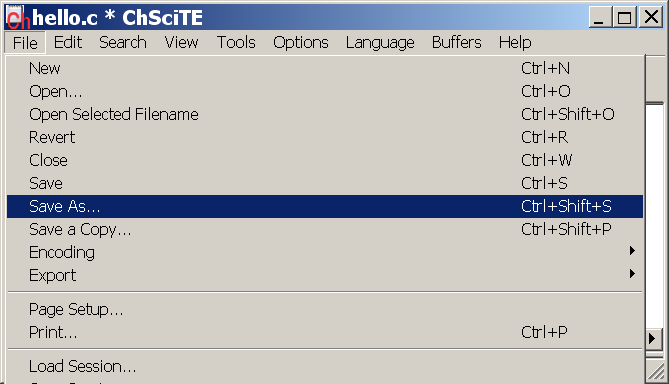
Figure 4: Save program hello.c
Perform the Tools | Run as shown in
Figure 5 to execute the program hello.c.
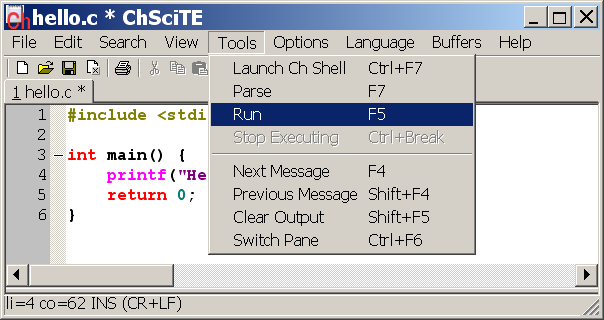
Figure 5: Executing program hello.c
Instead of performing the Tools | Run command, pressing function key F5
will have the same effect of executing the program.
The output window will be made visible if it is not already visible and will show:
>ch -u hello.c
Hello, world!
>Exit code: 0
as displayed in
Figure 6.

Figure 6: The output from executing program hello.c
The first blue line is from ChSciTE showing the command it will use to run the program. The black
line is the output from running the Ch program. The last blue line is from ChSciTE showing
that the program has finished and displaying its exit code. An exit code of zero indicates a
successful run.
ChSciTE understands the error messages produced by Ch.
To see this, add a mistake to
the Ch file by changing the line
printf("Hello, world");
to
printf("Hello, world";
Perform the Tools | Run the modified program. The results should look below
>ch -u hello.c
ERROR: missing ')'
ERROR: syntax error before or at line 4 in file hello.c
==>: printf("Hello, world\n";
BUG: printf("Hello, world\n"; <== ???
ERROR: cannot execute command 'hello.c'
>Exit code: 1
as shown in
Figure 7.

Figure 7: The error line in output from executing program hello.c
Click the line in output with red color in Figure 7,
the line with incorrect syntax will be highlighted as shown in
Figure 8.

Figure 8: Finding the error line in output from executing program hello.c
While it is easy to see where the problem is in this simple case, when a file is larger the
Tools | Next Message command can be used to view each of the reported errors. Upon performing
Tools | Next Message, the first error message in the output pane
and the appropriate line in the editing pane are
highlighted with a yellow background,
The caret is moved to this line and the pane is scrolled if needed to show the line. ChSciTE
now looks like in
Figure 8.
ChSciTE understands both the file name and line number parts of error messages in most cases
so can open another file (such as a header file) if errors were caused by that file. This
feature may not work where the file name is complicated by containing spaces or ".."
If command execution has failed and is taking too long to complete then the Tools | Stop
Executing command can be used.
On Windows, ChSciTE defaults to execute tools as command line programs. Executing a GUI
program in this mode results in that program being run without displaying a window.
The
command.subsystem option can be used to define tools that run in GUI mode. The default
subsystem, 0, is for command line programs, 1 is for programs which create their own windows,
and 2 is for using the
ShellExecute call.
To run a GUI program such as OpenGL and Windows,
use Tools | Launch Ch Shell command to launch a Ch shell. Run the GUI program in this shell.
On GTK+, the default subsystem 0
executes the tool and waits for it to finish, redirecting output to the output pane and
subsystem 2 executes the tool in the background.
Setup Paths and Finding Commands in Ch
When a command is typed into a prompt of a command shell
for execution, the command shell will search for the command
in prespecified directories.
In a Ch shell, the system variable
_path of string type
contains the directories to be searched
for the command.
Each directory is separated by a semicolon inside the string _path.
When a Ch command shell is launched,
the system variable _path contains some default search paths.
The user can add new directories
to the search paths for the command shell by using the string
function stradd() which adds arguments of string type and returns
it as a new string.
For example, the directory
C:/Documents and Settings/Administrator/c99
is not in the search paths for a command.
If you try to run program hello.c in this directory when the current
working directory is
C:/Documents and Settings/Administrator.
The Ch shell will not be able to find this program as shown below
and give two error messages.
C:/Documents and Settings/Administrator> hello.c
ERROR: variable 'hello.c' not defined
ERROR: command 'hello.c' not found
When Ch is launched or
a Ch program is executed, by default, it will
execute the startup file .chrc in Unix or
_chrc in Windows in the user's home directory
if it exists.
In the remaining presentation, it is assumed
that Ch is used in Windows with a startup file
_chrc in the user's home directory.
This startup file typically sets up the search paths
for commands, functions, header files, etc.
By default, there is no startup file in a user's home
directory.
The system administrator may add such a startup file
in a user's home directory.
However, the user can execute Ch with the option -d as follows
ch -d
to copy a sample startup file from
the directory CHHOME/config/ to
the user's home directory if there is no
startup file in the home directory yet.
Note that CHHOME is not the string "CHHOME", instead it uses the
file system path under which Ch is installed.
For example, by default, Ch is installed in
C:/Ch in Windows and /usr/local/ch in Unix.
In Windows, the command in a Ch shell below
C:/Documents and Settings/Administrator> ch -d
will create a starup file
_chrc in the user's home directory
C:/Documents and Settings/Administrator.
This local Ch initialization startup file
_chrc
can be opened for editing
the search paths by
ChSciTE editor as shown in
Figure 10.

Figure 10: Open the local Ch initialization startup file for editing.
To include the directory C:/Documents and Settings/Administrator/c99
in the search paths for a command,
the following statement
_path = stradd(_path, "C:/Documents and Settings/Administrator/c99;");
needs to be added
to the startup file _chrc in the user's home directory
so that
the command hello.c in this directory can be invoked regardless of what
the current working directory is. After the directory
C:/Documents and Settings/Administrator/c99 has been added to the
search path, _path, you need to restart a Ch command shell.
Then, you will be able to execute the program
hello.c in this directory as shown below.
C:/Documents and Settings/Administrator> hello.c
Hello, world
Similar to
_path for commands,
the header files in Ch are searched in
directories specified in
the system variable _ipath.
Each path is also delimited by a semicolon.
For example, the statement below
_ipath = stradd(_ipath, "C:/Documents and Setting/Administrator/c99;");
adds the directory
C:/Documents and Setting/Administrator/c99
to the search paths for header files.
One can also add this directory to the function file search paths
by the statement
_fpath = stradd(_fpath, "C:/Documents and Setting/Administrator/c99;");
In Unix, the search paths for commands by default do not contain
the current working directory.
To include the current working
directory in the search paths for a command,
the following statement
_path = stradd(_path, ".;");
in startup file .chrc in the user's home directory
needs to be added.
Function call
stradd(_path, ".;")
adds the current directory represented by
'.' to the system search paths _path.
The Second Example with Input.
This example will show how to run a C/Ch/C++ program/script that requires the user to input data. Type in the code as shown in
Figure 11.
The same program C:/Ch/demos/bin/scanf.c
can also be loaded using File | Open command.
During execution, this code should ask the user to "Please input a number" and then cause the system to output "Yout input number is" and the number that the user inputted.

Figure 11: A program with input from the user.
During the execution of the program, the user will be prompted to input a number as shown in
Figure 12.
The user then must type in a number in the same pane for both input and output.
Both input number of 56 and output are shown in
Figure 12.

Figure 12: Executing the program with input and output.
The Third Example with Plotting in Ch.
This example will show how to run a C/Ch/C++ program/script that creates a plot using Ch Professional Edition.
Type in the code as shown in
Figure 13.
The same program C:/Ch/demos/bin/fplotxy.cpp
as shown in Figure 13
can also be loaded using File | Open command.
When the program is executed, it creates a plot shown
in Figure 14.
The plotting function fplotxy() is available in Ch Professional Edition.
The program shown in Figure 13
uses the plotting function fplotxy() to plot function func() with 37 points and with the x value in the range from 0 to 360.

Figure 13: A plotting program using fplotxy().

Figure 14: The output of the plotting program.
The plotting function plotxy() is available to plot data stored in C arrays.
The program C:/Ch/demos/bin/fplotxy.cpp
shown in Figure 15 uses regular C array
to store the data used for plotting.
When the program
C:/Ch/demos/bin/plotxy.cpp
shown in
Figure 15
is loaded and executed, it creates the same plot shown
in Figure 14.
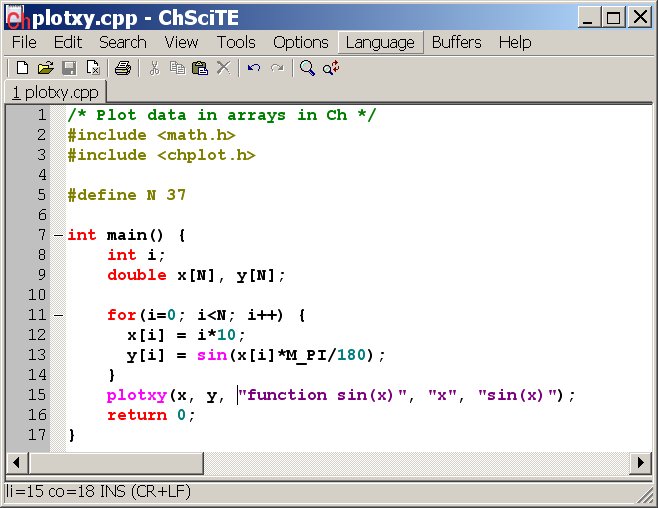
Figure 15: A plotting program using plotxy().
The plotting function fplotxy() can be used to plot three-dimensional functions with two variables
as shown in Figure 16.
This program plot function cos(x)sin(y) for the x value in the range from -3 to 3
and y in the range of -4 to 4. The plot uses 80 points for both x and y.
When the program
C:/Ch/demos/bin/fplotxyz.cpp
shown in
Figure 16
is loaded and executed, it creates the plot shown
in Figure 17.

Figure 16: A plotting program using fplotxyz().
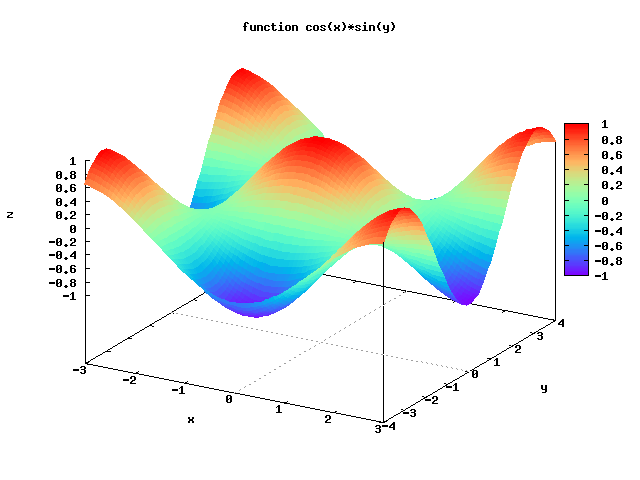
Figure 17: The output of the plotting program using fplotxyz().
Command Parameters and Prompting
ChSciTE has 4 properties $(1) .. $(4) which can be used to run commands with
changeable parameters. To set the parameter values, use the View | Parameters
command to view the modeless Parameters dialog which shows the current values
of these parameters and allows setting new values. The accelerator keys for the main
window remain active while this dialog is displayed, so it can be used to rapidly run
a command several times with different parameters. Alternatively, a command can be
made to display the modal Parameters dialog when executed by starting the
command with a '*' which is otherwise ignored. If the modeless Parameters dialog is
already visible, then the '*' is ignored.
The Fourth Example with Command Parameters.
This example will show how to run a C/Ch/C++ program/script with command parameters. Type in the code as shown in
Figure 18.
This program will accept the command parameters and print them out.
The parameters are setup in View|Parameters menu as shown in
Figure 19
and Figure 20
The output from execution of this program with command parameters is displayed in
Figure 21
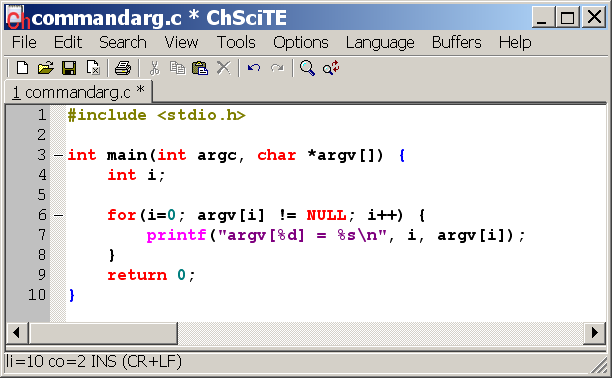
Figure 18: A program for handling command parameters.

Figure 19: Setup command parameters.
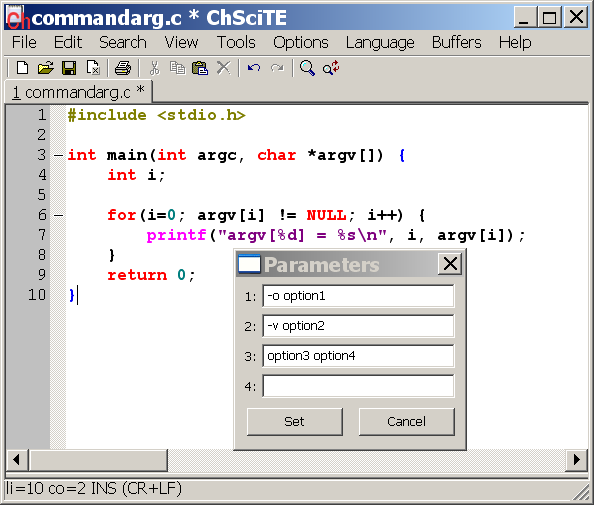
Figure 20: Setup command parameters.

Figure 21: Executing the program with command parameters.
Buffers
ChSciTE has 20 buffers each containing a
file.
The Buffers menu can be used to switch between buffers, either by selecting the
file name or using the Previous (F6) and Next (Shift+F6) commands.
When all the buffers contain files, then opening a new file causes a buffer to be reused
which may require a file to be saved. In this case an alert is displayed to ensure the user
wants the file saved.
Sessions
A session is a list of file names. You can save a complete set of your
currently opened buffers as a session for fast batch-loading in the
future.
Sessions are stored as plain text files with the extension ".ses".
Use File | Load Session and File | Save Session to load/save sessions.
You can turn on/off "last session autoloading" using ChSciTE properties
variable "save.session".
By default, session management is turned on.
Loading previously saved session will close your currently opened
buffers. However you will not loose your edits, because you will be
asked to save unsaved buffers first.
Opening a specific file from command line overrides "save.session"
variable state. When you start ChSciTE loading a specific file from
command line last session will not restore even if "save.session"
variable is set to "1". This makes "save.session" safe to use - you
will never open a couple of files when you are trying to open just
one, specific file.
Languages Understood by ChSciTE
ChSciTE currently is able to syntax style these languages (* denotes
support for folding):
- C/Ch/C++*
- CSS*
- HTML*
- Make
- SQL and PLSQL
- TeX and LaTeX
- XML*
Language settings are determined from the file extension but this can be changed
by selecting another language from the Language menu. The language menu can be
changed with the menu.language property.
Find and Replace
ChSciTE has options to allow searching for words, regular expressions,
matching case, in the reverse direction, wrapping around the end of the
document.
C style backslash escapes which are listed in the command line
arguments section, may be used to search and replace control
characters.
Replacements can be made individually, over the current selection or
over the whole file. When regular expressions are used tagged
subexpressions can be used in the replacement text.
Regular expressions will not match across a line end.
ChSciTE supports
basic regular expressions
with tagging.
Keyboard Commands
ChSciTE uses the default key bindings defined in Scintilla, so
keyboard commands in ChSciTE mostly follow common Windows and GTK+ conventions.
All move keys (arrows, page up/down, home and end)
allows to extend or reduce the stream selection when holding the Shift key,
and the rectangular selection when holding the Shift and Alt keys.
Some keys may not be available with some national keyboards or because
they are taken by the system such as by a window manager on GTK+.
The user.shortcuts setting may be used to assign a key to a function.
Note that Home key behaviour is changed by the vc.home.key option.
Keyboard equivalents of menu commands are listed in the menus.
Some less common commands with no menu equivalent are:
| Run C/Ch/C++ program. | F5 |
| Parse C/Ch/C++ program. | F7 |
| Launch Ch shell. | Ctrl+F7 |
| Magnify text size. | Ctrl+Keypad+ |
| Reduce text size. | Ctrl+Keypad- |
| Restore text size to normal. | Ctrl+Keypad/ |
| Cycle through recent files. | Ctrl+Tab |
| Indent block. | Tab |
| Dedent block. | Shift+Tab |
| Delete to start of word. | Ctrl+BackSpace |
| Delete to end of word. | Ctrl+Delete |
| Delete to start of line. | Ctrl+Shift+BackSpace |
| Delete to end of line. | Ctrl+Shift+Delete |
| Go to start of document. | Ctrl+Home |
| Extend selection to start of document. | Ctrl+Shift+Home |
| Go to start of display line. | Alt+Home |
| Extend selection to start of display line. | Alt+Shift+Home |
| Go to end of document. | Ctrl+End |
| Extend selection to end of document. | Ctrl+Shift+End |
| Go to end of display line. | Alt+End |
| Extend selection to end of display line. | Alt+Shift+End |
| Expand or contract a fold point. | Ctrl+Keypad* |
| Create or delete a bookmark. | Ctrl+F2 |
| Go to next bookmark. | F2 |
| Select to next bookmark. | Alt+F2 |
| Find selection. | Ctrl+F3 |
| Find selection backwards. | Ctrl+Shift+F3 |
| Scroll up. | Ctrl+Up |
| Scroll down. | Ctrl+Down |
| Line cut. | Ctrl+L |
| Line copy. | Ctrl+Shift+T |
| Line delete. | Ctrl+Shift+L |
| Line transpose with previous. | Ctrl+T |
| Line duplicate. | Ctrl+D |
| Find matching preprocessor conditional, skipping nested ones. | Ctrl+K |
| Select to matching preprocessor conditional. | Ctrl+Shift+K |
| Find matching preprocessor conditional backwards, skipping nested ones. | Ctrl+J |
| Select to matching preprocessor conditional backwards. | Ctrl+Shift+J |
| Previous paragraph. Shift extends selection. | Ctrl+[ |
| Next paragraph. Shift extends selection. | Ctrl+] |
| Previous word. Shift extends selection. | Ctrl+Left |
| Next word. Shift extends selection. | Ctrl+Right |
| Previous word part. Shift extends selection | Ctrl+/ |
| Next word part. Shift extends selection. | Ctrl+\ |
Abbreviations
To use an abbreviation, type it and use the Expand Abbreviation
command or the Ctrl+B key. The abbreviation is replaced by an
expansion defined in the Abbreviations file. You can open the
Abbreviations file with a command in the Options menu and
add abbreviations.
Each line in the files looks like "abbreviation=expansion".
The abbreviations names can have any character (except perhaps control chars,
surely for CR and LF), including high Ascii chars (accented chars).
Names have properties files limits: they cannot start with sharp (#) or space or tab
(but can have spaces inside); and they cannot have '=' character inside.
Abbreviations names are limited to 32 characters. It is probably enough for
abbreviations...
An expansion may contain new line characters indicated by '\n' and
a caret position indicated by the '|' character. To include a literal '|'
character, use '||'.
Some simple examples are included in the distributed Abbreviations file.
When expanding, the names don't need to be separated from the previous text.
i.e. if you define '‰' as 'é', you can expand it inside a word.
If a name is the ending of another one, only the shorter will ever be expanded.
Ie. if you define 'ring' and 'gathering', the later will see only the 'ring' part expanded.
Folding
ChSciTE supports folding for many languages (see the list of languages
understood by ChSciTE for more information.)
Fold points are based upon indentation for C and on counting braces
for the other languages. The fold point markers can be clicked to
expand and contract folds. Ctrl+Shift+Click in the fold margin
will expand or contract all the top level folds. Ctrl+Click on a fold
point to toggle it and perform the same operation on all children.
Shift+Click on a fold point to show all children.
Encodings
ChSciTE will automatically detect the encoding scheme used for Unicode files that
start with a Byte Order Mark (BOM).
The UTF-8 and UCS-2 encodings are recognized including both Little Endian and
Big Endian variants of UCS-2.
UTF-8 files will also be recognized when they contain a coding cookie on one of the
first two lines. A coding cookie looks similar to "coding: utf-8" ("coding" followed by ':'
or '=', optional whitespace, optional quote, "utf-8") and is normally contained in
a comment:
# -*- coding: utf-8 -*-
For XML there is a declaration:
<?xml version='1.0' encoding='utf-8'?>
For other encodings set the code.page and character.set properties.
|

